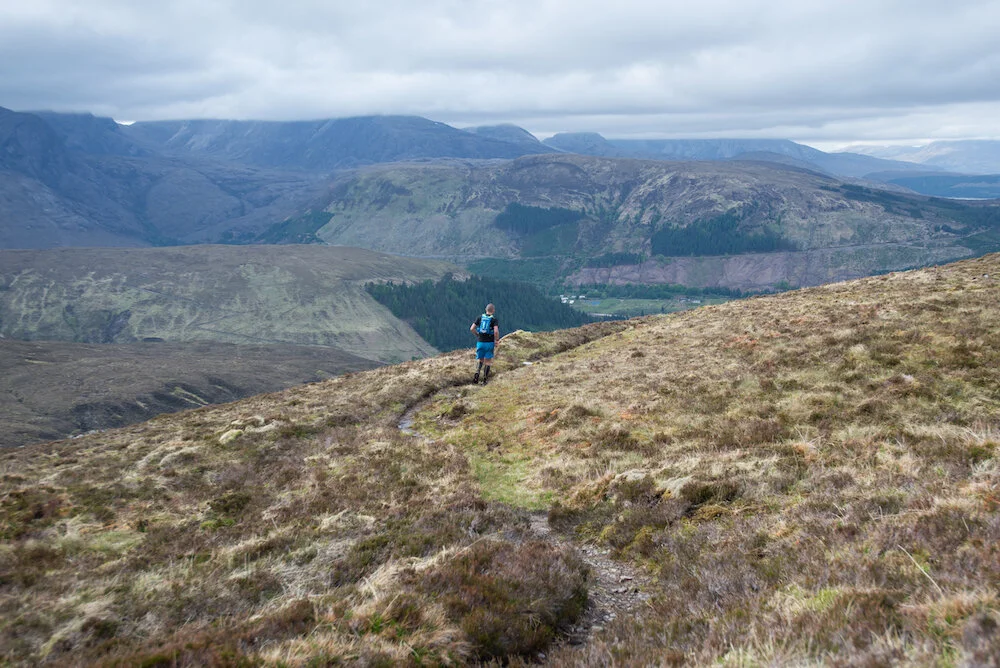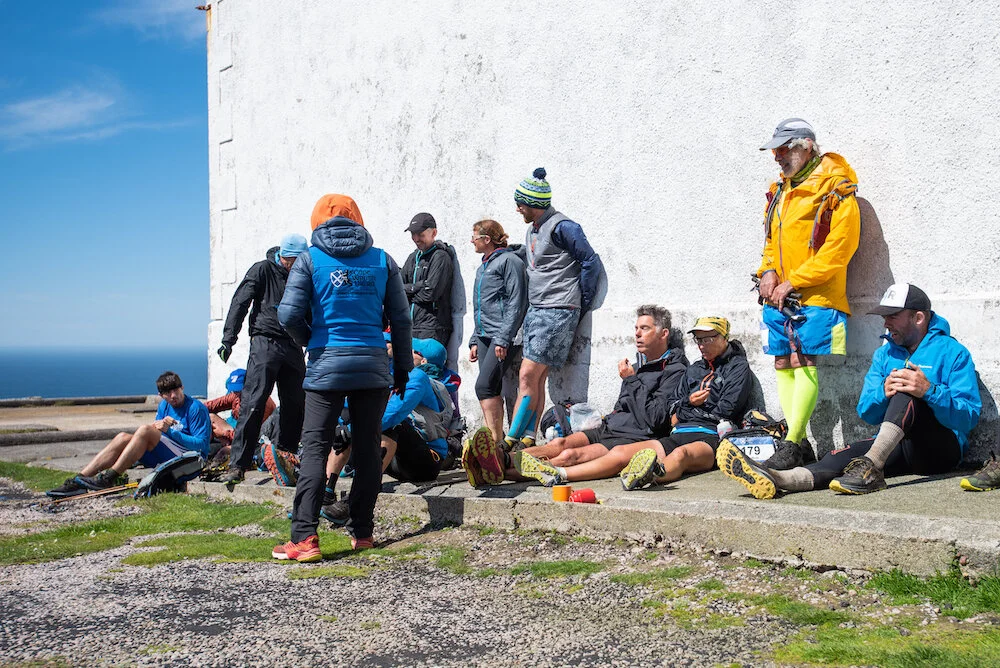Cape Wrath Ultra® 2021 - event format and rule changes/clarifications
Observant participants now entering the 2021 edition of the Cape Wrath Ultra® will have spotted some subtle but important changes to the format and rules of the event. Ordinarily this would have passed without comment, as we continually update and fine tune each event. However, because almost 300 participants have transferred their entry from 2020 to the 2021 edition, we wanted to make these changes crystal clear. In all cases we are making these changes so that we increase fairness between participants, improve the efficiency of our complex logistics, and most importantly, increase the margin of safety for everyone involved in the event.
Course closure time
How it was: In the previous editions of the event we have had a flexible start time of between 07:00 and 09:00 each morning, and a course closure time of 23:00 each evening. Any participant arriving at the overnight camp after the course closure time is automatically timed-out from that day’s racing and will not be able to start the full course on the following day. Thereafter they can only continue as a non-competitive runner starting the reduced course (when available) the following day subject to our transport logistics.
Once timed-out, participants are unable to complete the full course, and therefore we recognised that this is a big deal.
What we have changed: We have changed the course closure time to 22:00 on days 1, 2, 4, 5, 6 and 7. There is one hour less to complete the course one each of these days. The course closure time will remain at 23:00 for day 3 (the time it was for the 2016 and 2018 editions).
This change is a compromise to our planned change of making the course closure time 22:00 on all days (this will now only happen for the 2022 edition).
Why we are changing: There are a number of important reasons we have changed the course closure time. First of all, very late finishers result in a disproportionate number of event staff (Race Control, Safety Team, Catering, Logistics etc) being up very late, and historically we have seen many more retirements and emergency evacuations from the course the following day, as exhausted ‘late finishers’ from the previous day fail to complete the course. Additionally, and most importantly, there is a limit to how tired we can allow the event staff to become, whilst they carry out safety-critical roles, and/or simply need to drive a vehicle safely the following morning.
The number of runners finishing after 22:00 is very small. Some who do finish after 22:00 retired then and there (shown below – although note participants also retire at other locations/times). Some only miss the 22:00 course closure time by minutes and we feel it would be reasonable to expect these participants to speed up just a little if they knew the course closure time was 22:00 and not 23:00. Some start much later than our earliest 07:00 start time and this puts them (and us) under undue pressure later that evening.
After the 2018 Cape Wrath Ultra® we did some very careful analysis of all the participants to understand how many finished after 22:00. Here is the summary:
Day 1. Finished after 22:00 = None
Day 2. Finished after 22:00 = 8 (6 retired)
Day 3. Finished after 22:00 = 28* (6 retired) / Finished after 23:00 = 4
Day 4. Finished after 22:00 = None
Day 5. Finished after 22:00 = None
Day 6. Finished after 22:00 = 4** (4 retired)
Day 7. Finished after 22:00 = 6*** (4 retired)
* Day 3. 13 of these participants finished before 22:30
** Day 6. These 4 participants finished at 22:03
*** Day 7. The two participants who did not retire finished at 22:02
If you would like to understand more about course closure time and also the cut-off times and what options this leaves for a participant timed-out, please have a careful read of the following two guidance articles:
The course closure time will remain at 23:00 for day 3 ©Jimmy Hyland
Going to Cape Wrath lighthouse, and getting off the Cape
How it was: In previous editions of the Cape Wrath Ultra® we succeeded in enabling any participant who was still with the event on the morning of day 8, the option of going to the Cape Wrath Lighthouse. This included all the non-competitive participants. There are no shortcuts or insertions possible on day 8, and participants need to complete day 8 in full to reach Cape Wrath Lighthouse, and then connect with our very special and complex logistics to evacuate everyone off the Cape that day.
What we are clarifying: We are not changing anything, just clarifying that we are unable to guarantee that non-competitive participants can complete day 8 and the event website already states: “On day 8 it is unlikely that non-competitive participants will be able to complete day 8 to Cape Wrath due to our complex extraction logistics. We will assess the situation based on the number of competitive participants left in the event and the number of non-competitive participants wishing to start day 8 and share this information during the event.”
We will also enforce mandatory start times on day 8 for all participants, and these will range over a larger time frame between 07:00 to 11:00 depending on the final numbers. The fastest runners will be starting first so that we can spread the finishers over the widest time frame at Cape Wrath Lighthouse.
Why are we doing this: There are some very special and complex logistics that concern day 8 only. Whilst connected to mainland, Cape Wrath itself is extremely remote and only accessible by a mini-bus journey, and tiny passenger boat transfer. Additionally, providing safety and emergency cover on this day is particularly challenging. We recognise that Cape Wrath itself is a special location and provides the emotional finish to the event regardless of whether you have completed all the days or not. We want to give ourselves the best possible chance of allowing non-competitive participants the opportunity to get to Cape Wrath Lighthouse hence the new start time arrangements for day 8 only. However, we also need to recognise that the logistics of getting everyone off the Cape are not entirely within our control, with the number of mini-buses available on the day and the weather, having a significant impact.
Waiting at Cape Wrath for the boat and mini bus transfer to Durness ©Jimmy Hyland
Mandatory Ortlieb dry bag
How it was: Previously we recommended an Ortlieb PS490 dry bag (79L) for use as participants’ dry bag, but participants were free to bring any dry bag so long as it was strictly 80L or less.
What we have changed: The Ortlieb PS490 dry bag (79L) is now mandatory for new 2021 participants but remains only (highly) recommended for participants transferring from the 2020 event. We recognise that many 2020 participants had already bought a dry bag and we wanted to compromise here. However, we would like to be crystal clear that any participant presenting a dry bag at registration that is larger than 80L or not completely waterproof will be required to buy an Ortlieb PS490 dry bag (79L) from us there and then and re-pack before they can complete registration. Our benchmark for the 80L size is the 79L Ortlieb PS490 dry bag.
Why are we doing this: We keep fighting the same battle with a small number of participants at each registration for our two expedition races; they arrive with a dry bag that is either obviously larger than 80L and/or not waterproof and/or lightweight and easily damaged. We are introducing this change for a number of reasons:
Fairness. We want all participants to have the same size dry bags, and not have a small number of participants who are gaming the rules having found dry bags that might state 80L but are clearly much larger.
Logistics. It helps us considerably if we can accurately and reliably predict how many dry bags will fit in one vehicle and this is only possible if the dry bags are known to be the same size pre-event. Stacking drybags that are a uniform size and type is also much easier for the Event Team, and the very robust nature of these Ortlieb dry bags are known to withstand that rough handling they receive at the event.
Safety: The dry bags are stored outside before being collected by participants at the overnight camp. If the weather is poor these dry bags potentially sit in water pooling on the ground and in the rain. It is essential that participants’ spare clothing and sleeping bags are dry so that they can recover at the overnight camp.
Your dry bag needs to be tough, robust and 100% waterproof ©Jimmy Hyland




